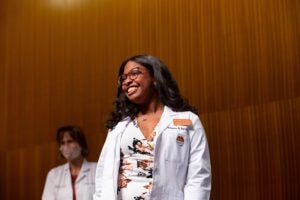
This story was originally featured on Feb. 4, 2008.
In a sea of white faces, John Saunders Chase waited patiently amid the stares and glares of the swarm of humanity surrounding him. Cameras flashed as reporters hurled questions at him and jotted down his responses.
It was June 7, 1950. Chase, an African American, was smartly dressed in a double-breasted coat and tie, as he stood in line at Gregory Gym.
Only vaguely aware of the name Heman Marion Sweatt, Chase wasn’t standing in line with the intention of making history. Nor was he purposefully making a statement about social injustice. He, like the thousands of other students in the gym, waited in line for a basic rite of passage on a university campus. He was waiting to enroll.
Just two days prior, the United States Supreme Court had ruled in favor of desegregation in three separate civil rights cases. Two of the cases, McLaurin v. Oklahoma State and Henderson v. United States, focused on banning separate facilities at a university and prohibiting segregated seating arrangements on railroad cars, respectively.
The third case, Sweatt v. Painter, concerned equal education opportunities — specifically, the right of African Americans to enroll in the School of Law at The University of Texas at Austin. The court voted in favor of desegregation of graduate and professional schools (the undergraduate level did not desegregate until the ruling of Brown v. Board of Education in 1954) and The University of Texas at Austin became the first major public university in the south to open its doors to African Americans.
Chase, born in Annapolis, Md., was 25 years old at the time. Although nervous, he recalls being befuddled at the fanfare that greeted his arrival.
“I remember, specifically, a photographer who talked non-stop to me about making history and getting the ‘right moment’ on film,” Chase said. “He told me that I wasn’t officially accepted into the university until it became a ‘contract’ — in other words, until the university took my money. He was right there next to me at that moment to snap a photo.”
The road to “that moment” began at an early age for Chase. Growing up, he idolized his older sister and was devoted to following in her footsteps. When she enrolled at Hampton University in Virginia he was destined to do the same. And although he knew what he wanted to do in life, he was, originally, at a loss to define it.
“As a child, I loved to draw and to create things like buildings and airplanes,” said Chase. “I knew what I loved to do, but didn’t really understand the concept of architecture until one day when I knocked on the front door of an architecture firm on West Street in Annapolis and told them I wanted to learn about what they did.
“Even though the members of the firm were white, they took me in and treated me like one of their own. They sat me at drafting tables and pulled out rolls of plans to show me. And, to this day, I am good friends with members of that firm.”
Chase earned a bachelor of science degree in architecture from Hampton University in 1948, and he never wavered in his determination to become an architect. Architecture was his life-long passion and he was determined to realize his dream. Only, unknown to him, his dream was colorblind and the world around him wasn’t.
Continue reading the full article to learn about Chase’s experience at the School of Architecture at The University of Texas at Austin.



